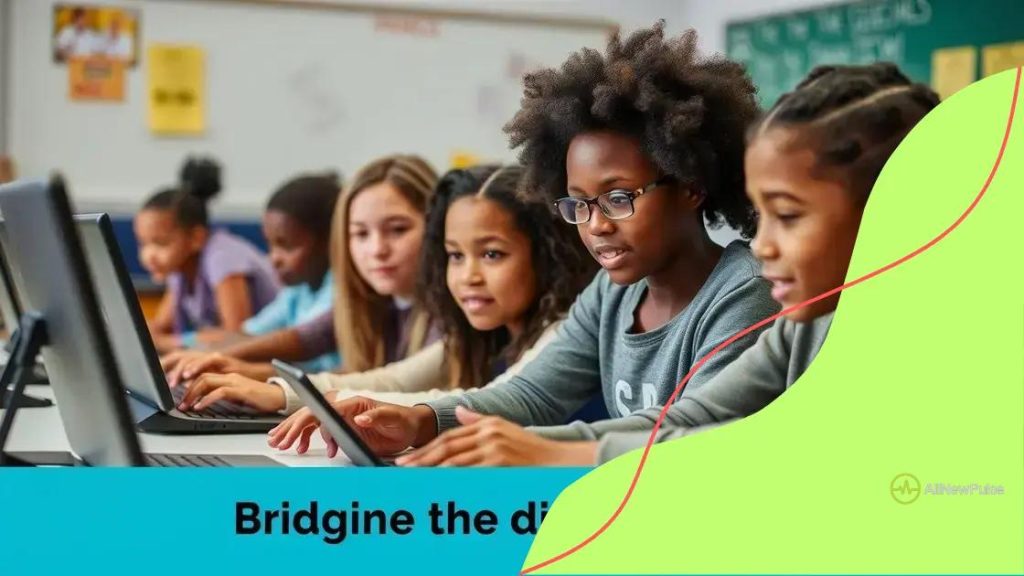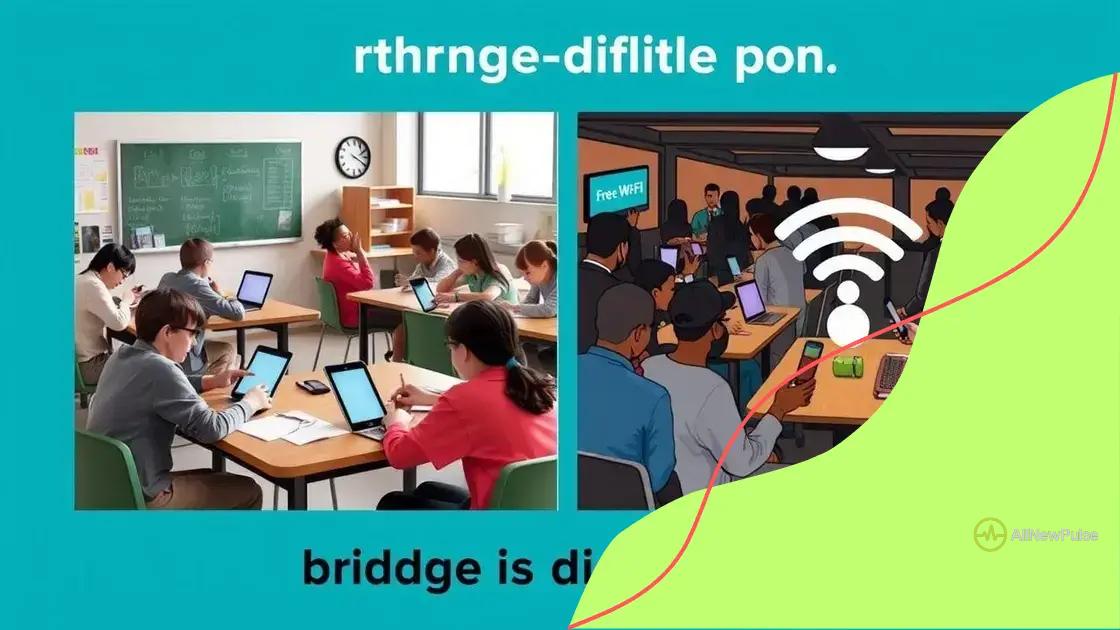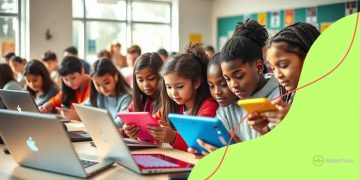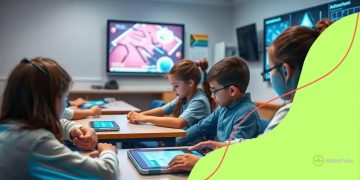Addressing the digital divide in schools: a crucial need

Addressing the digital divide in schools requires strong community and government collaboration to provide technology and internet access, ensuring that all students have the resources needed for effective learning.
Addressing the digital divide in schools is more important than ever. Imagine students being barred from quality education simply due to lack of technology access. Let’s explore this pressing issue together.
Understanding the digital divide’s impact on education
Understanding the digital divide is essential, especially in today’s educational landscape. This divide affects many students, particularly those in low-income areas. As technology becomes more integrated into learning, addressing these gaps is crucial.
Impact on Learning Outcomes
Many studies show that students without reliable internet access struggle in their studies. They miss out on valuable resources that enhance learning. A lack of technology can lead to lower grades and engagement.
Consequences for Future Opportunities
When students cannot access technology, their future job prospects suffer. In a world that increasingly relies on digital skills, not bridging this divide leads to greater gaps in socioeconomic status.
- Students without tech resources may fall behind academically.
- Future employment opportunities require digital skills.
- Investing in technology can improve overall educational standards.
Moreover, the divide can influence classroom dynamics. Teachers often work with unequal resources. This disparity can create frustration and limit the effectiveness of educational programs.Bridging the digital divide is not just about technology; it’s about equity in education.
Various initiatives aim to address this issue. Programs that provide devices and internet connectivity have shown success. Schools partnering with tech companies create opportunities for improvement.
Community Involvement
Community support plays a significant role in overcoming the digital divide. Local governments, nonprofits, and businesses can collaborate to provide resources. By working together, these groups can ensure every student has the tools they need to succeed.
Key statistics on technology access in schools
Key statistics reveal the stark reality regarding technology access in schools. These numbers play a vital role in understanding the digital divide that affects many students today.
Access to Devices
Recent data shows that many students do not have adequate access to devices. For example, a survey found that almost 30% of students in low-income areas report sharing devices with siblings, limiting their study time. In comparison, students in wealthier districts often have a personal device available for learning.
Internet Connectivity
Internet access further highlights disparities. Approximately 20% of households with school-aged children lack a reliable internet connection. This lack of connectivity makes it challenging for students to complete assignments or participate in online classes.
- Over 14 million students live in areas without broadband access.
- Rural areas experience greater connectivity issues than urban centers.
- Schools with high poverty rates struggle to provide students with necessary tech access.
These statistics emphasize the pressing need for action. Efforts must focus on ensuring all students receive the required resources for success. Several organizations and initiatives aim to provide technology and resources to underserved schools.
Government Initiatives
Government programs are also addressing this issue. The Federal Communications Commission (FCC) has launched initiatives to support schools in acquiring the technology they need. These efforts highlight how public policy can drive change and improve student access to technology.
Innovative strategies to bridge the digital gap

Innovative strategies are essential to bridge the digital gap in education. As schools adapt to changing technologies, creative solutions can help ensure all students have access to vital learning resources.
Providing Devices
One effective approach is to provide students with personal devices. Programs that supply laptops or tablets can remove barriers to access. Many schools partner with tech companies to offer affordable devices, ensuring students can learn both in and out of the classroom.
Expanding Internet Access
Improving internet connectivity is another crucial strategy. Schools can work with local governments to expand broadband coverage in underserved areas. Community Wi-Fi initiatives allow students to connect outside school grounds, providing greater access to online resources.
- Mobile hotspots can be distributed to families without internet access.
- Partnerships with internet service providers can lower costs.
- Incentives for businesses to offer free public Wi-Fi can increase community access.
In addition to providing devices and internet access, training for teachers and students is vital. Professional development programs equip teachers with the skills to integrate technology effectively. Students also benefit from workshops that teach them how to use digital tools for learning.
Utilizing Community Resources
Another innovative strategy is leveraging community resources. Local libraries can serve as technology hubs, providing access to computers and internet. Community organizations often offer tutoring programs that include technology training. By fostering partnerships, schools can enhance the resources available to students.
The role of community and government in support
The role of community and government support is crucial in bridging the digital divide in schools. By working together, these entities can ensure that all students have access to the technology they need for education.
Community Involvement
Communities can take active steps to support schools. Local organizations often provide resources such as funding for technology or workshops to teach students and parents about digital skills. When communities unite, they amplify efforts to close the technology gap.
Government Initiatives
Government programs can significantly help schools acquire necessary technology. For instance, grants and funding initiatives allow schools to purchase devices and improve internet infrastructure. These programs can target low-income areas where the need is greatest.
- Local governments can create initiatives that increase broadband access.
- Public policies can promote partnerships between schools and tech companies.
- Federal funding can support training for educators on new technologies.
Collaboration between government and community groups fosters innovation. Examples include school-community partnerships that provide after-school programs focused on digital literacy. When schools tap into local expertise, they enhance student learning opportunities.
Success Stories
Many success stories highlight the impact of community and government collaboration. For example, some districts have launched programs where tech companies donate devices to students in need. Others have created community Wi-Fi networks, enabling families to connect at home. These efforts show that uniting resources can effectively address the digital divide.
Success stories: schools overcoming digital challenges
Success stories of schools overcoming digital challenges inspire hope and show that bridging the digital divide is possible. These examples highlight innovative solutions and community efforts that significantly improve access to technology for students.
Case Study: Tech Access in a Rural School
One rural school district partnered with local businesses to provide every student with a laptop. The initiative transformed learning by allowing students to access online resources. This collaboration also ensured that families received training on how to use technology effectively.
Community Wi-Fi Initiatives
Another school implemented a community Wi-Fi project that set up hotspots around the neighborhood. This enabled students without internet access at home to complete their assignments in a safe environment. The program received support from local government, increasing its reach and sustainability.
- Students reported improved grades and engagement after receiving laptops.
- Cities have embraced initiatives to expand internet access in low-income neighborhoods.
- Collaborative training programs helped teachers integrate technology into their lessons.
Several urban schools have also launched after-school programs to teach digital skills. These programs not only improve technology use but also build confidence in students. With mentorship from community volunteers, students learn to navigate both software and hardware effectively.
Impact on Student Performance
Schools that tackle these challenges often see improved student performance and engagement. For instance, schools that provide one-on-one devices tend to enhance personalized learning experiences. Students are more willing to participate in lessons when they feel confident using technology.
FAQ – Frequently Asked Questions about Addressing the Digital Divide in Schools
What is the digital divide?
The digital divide refers to the gap between individuals who have access to technology and the internet and those who do not, impacting their ability to participate in education.
How can communities help bridge the digital divide?
Communities can support schools by providing resources, such as funding for technology, offering training sessions, and creating initiatives to expand internet access.
What role does the government play?
The government can implement policies and programs that provide funding and resources to schools, ensuring that all students have access to necessary technology.
What are some success stories of schools overcoming digital challenges?
Success stories include schools that have partnered with local businesses to provide laptops or implemented community Wi-Fi projects, greatly improving access for students.





